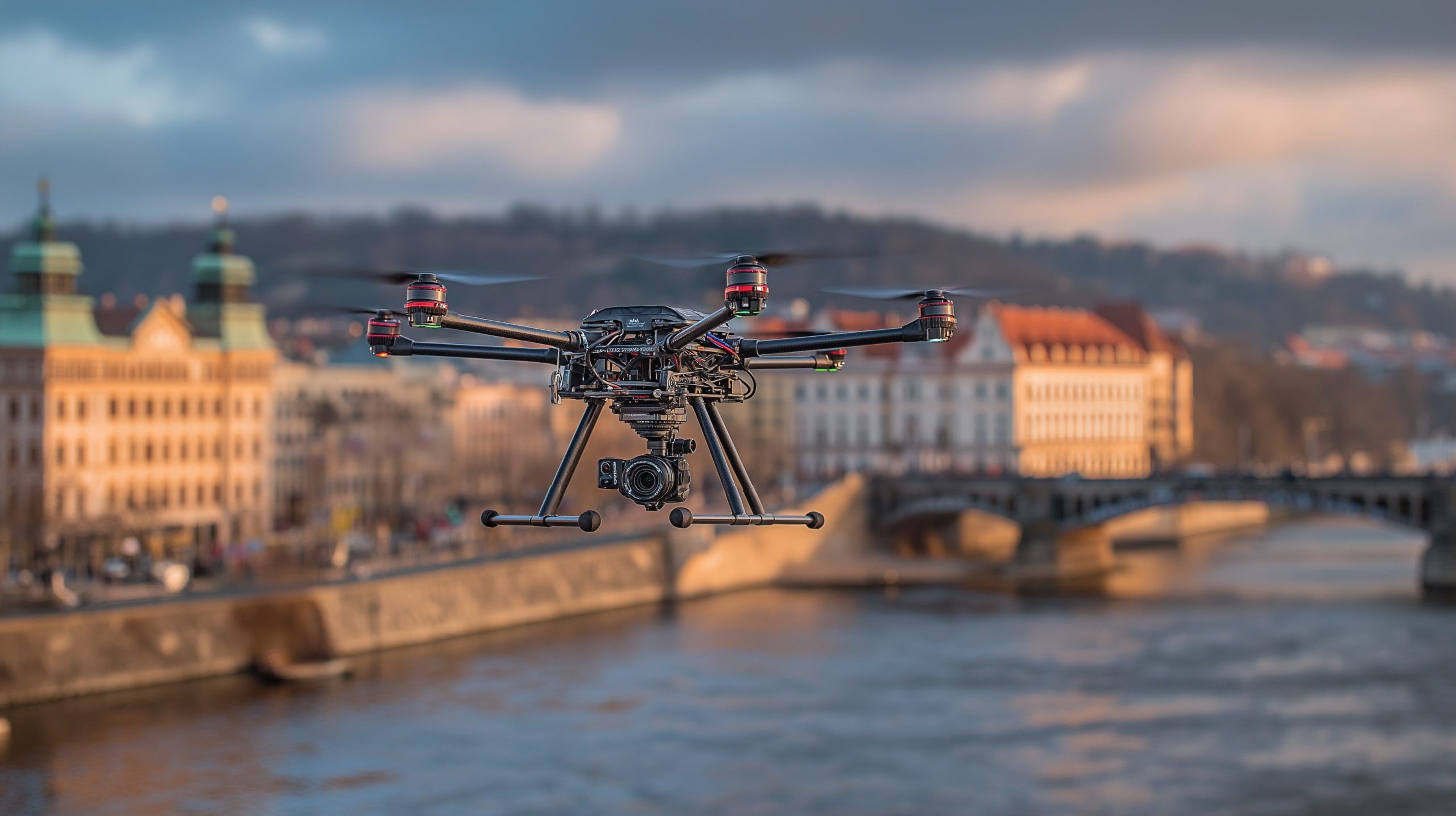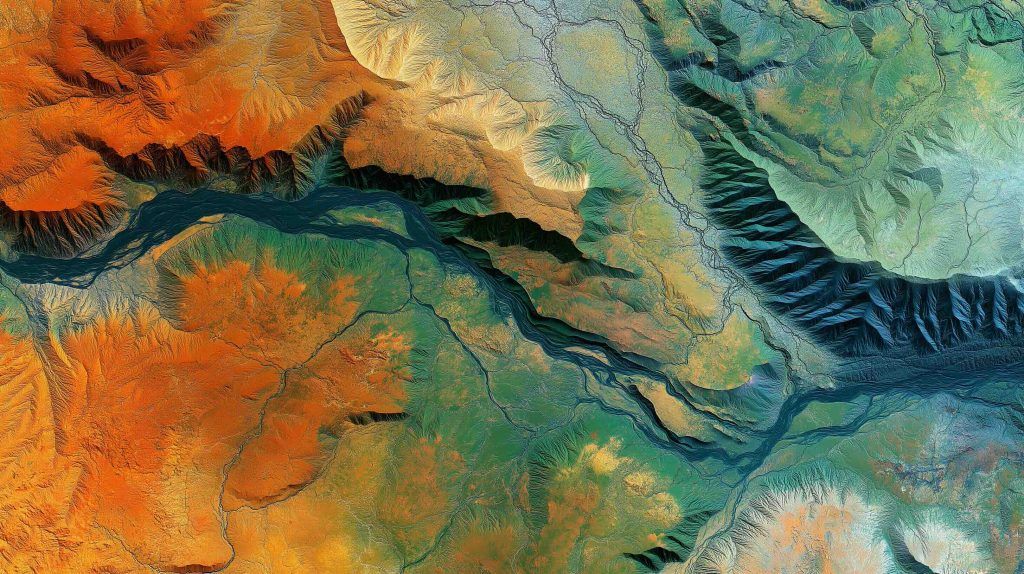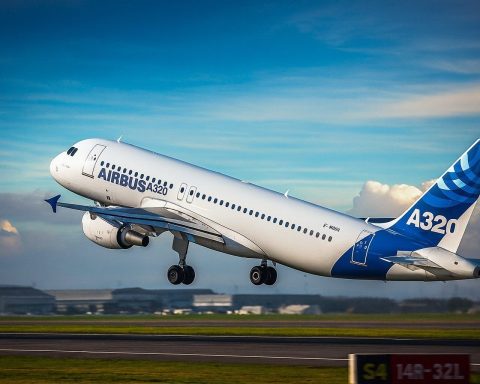- The EU drone rules classify operations into Open, Specific, and Certified, with Open further divided into A1, A2, and A3 subcategories.
- In Prague, almost all areas lie within restricted airspace LKR9, requiring Specific category authorization for most flights.
- Prague Castle, Charles Bridge, and the downtown area fall under the no-fly LKP1 zone, with no drones allowed there unless extreme government clearance.
- Prague Airport’s CTR prohibits flights within 5.5 km of LKPR without ATC coordination and constrains flights inside CTR to 100 m AGL or below.
- The standard maximum altitude is 120 m AGL in the Czech Republic, with lower limits in CTR and other zones; always check local limits.
- As of 2024, EU rules require most drones to broadcast a Remote ID; newer models have built-in Remote ID and older drones can require a retrofit.
- Operators must register with the Czech Civil Aviation Authority (CAA-CZ) via dron.caa.cz and obtain an Operator Registration ID that must be displayed on the drone; EU registrations from other countries are valid in Czechia.
- Fines can reach up to CZK 1,000,000 for serious offenses and up to CZK 5,000,000 in extreme cases; 2024 enforcement included 28 fines totaling CZK 330,000.
- There were over 80,000 registered drone pilots in the Czech Republic by mid-2025.
- The DronView geozone map shows Prague largely in red or yellow zones; the city center is effectively off-limits and flights should be planned outside restricted areas.
Overview: Why You Must Know the Rules
Prague’s picturesque skyline – from the spires of Old Town to Prague Castle – tempts many drone enthusiasts to capture its beauty from above. However, flying a drone in Prague is highly regulated. The Czech Republic follows unified EU drone regulations (in force since 2021) [1], layered with local no-fly zones and restrictions in Prague’s urban area [2]. Both recreational hobbyists and commercial drone pilots must adhere to these rules or risk heavy penalties. Fines can reach up to CZK 1,000,000 for serious violations (and up to CZK 5,000,000 in extreme cases) [3] [4], and authorities actively enforce bans around sensitive sites like airports and Prague Castle. In this comprehensive guide, we break down EU categories, registration, local Prague rules, privacy laws, and practical tips so you can enjoy drone photography safely and legally in the Golden City.
EU Drone Regulations in Czech Republic (EU Framework)
Czechia is bound by EU-wide drone laws established by the European Union Aviation Safety Agency (EASA) [5]. These rules classify all drone operations into three risk-based categories: Open, Specific, and Certified. Most recreational and routine commercial flights fall under the “Open” category (low risk), which is further divided into subcategories A1, A2, A3 [6]. Higher-risk or specialized operations (beyond Open limits) require authorization under the Specific category, and only the most complex missions (e.g. heavy drones or transporting people) are in the Certified category (similar requirements to manned aviation).
Table: EU Open Category Drone Subcategories (as of 2024) – Summary of weight classes, operational limits, and pilot requirements:
| Subcategory | Typical Drone Class/Weight | Where/How You Can Fly | Pilot & Registration Requirements |
|---|---|---|---|
| A1 – “Fly Over People” | – Class C0 (<250g) or C1 (<900g) drones [7] – Legacy drones <250g (no class label) | – Allowed: Fly over uninvolved people minimally (avoid hovering; no flight over crowds/assemblies) [8] [9]. – Altitude: ≤120 m AGL (400 ft) [10]. – No dropping of objects. | – Registration: Required if drone ≥250g or has a camera (unless it’s a toy) [11] [12]. – Pilot license: For C0: No formal training (read user manual) [13]. For C1: Online training + basic A1/A3 exam certificate [14] (minimum age 16). |
| A2 – “Fly Close to People” | – Class C2 drones (<4 kg) [15] – Some legacy drones ~500g–2kg (transitional) | – Allowed: Fly no closer than 30 m horizontally from uninvolved people (can reduce to 5 m if low-speed mode enabled) [16]. – Forbidden: No overflight of uninvolved persons [17] or crowds. – Altitude: ≤120 m AGL. | – Registration: Required (drone >250g) [18]. – Pilot license: Must first have A1/A3 certificate, then pass an additional A2 theory exam (and declare practical self-training) [19]. Minimum age 16. |
| A3 – “Fly Far from People” | – Class C3/C4 (<25 kg) [20] or any drone up to 25 kg operated in “A3” mode | – Allowed: Only in areas free of uninvolved people. Must maintain 150 m distance from residential, commercial, or industrial areas [21] (essentially, stay in wide open spaces). – Altitude: ≤120 m AGL [22]. – No flights over assemblies of people. | – Registration: Required if drone ≥250g or has camera [23]. – Pilot license: Online training + A1/A3 certificate (basic competency exam) required [24]. Minimum age 16 (per Czech rules) [25]. |
Specific Category: If you cannot fly within Open category limits (for example, your operation is in a densely populated area, at night beyond line-of-sight, or with a heavier drone), you must obtain a Special Flight Authorization from the Czech CAA under the Specific category [26] [27]. This involves a risk assessment or using a predefined risk scenario (PDRA) and getting explicit permission for each operation. In practice, Prague city flights almost always require Specific category authorization (see Prague restrictions below). Unless you’re an operator with a certified scenario or Light UAS Operator Certificate (LUC), flying in Specific category is a complex process beyond the scope of casual users.
Certified Category: Reserved for the highest-risk operations (e.g. drone delivery over cities, passenger drones, etc.), requiring aircraft-type certification and pilot licensing akin to manned aviation [28]. This is not applicable for standard hobby or camera drone use in Prague.
Drone Registration & Operator Licensing in Czechia
Operator Registration: Under EU rules, drone operators (the person or entity responsible for the drone) must register with the national aviation authority if their drone weighs 250 g or more, or if it’s under 250 g but equipped with a camera or any sensor capable of personal data collection (unless it’s a toy certified for under-14 use) [29]. In other words, almost all camera drones must be registered, even sub-250g models, because they can record data. The Czech Civil Aviation Authority (CAA-CZ) provides an online registration portal at dron.caa.cz [30]. Upon registering, you receive a unique Operator Registration ID that must be affixed visibly on all your drones [31] (and encoded in the drone’s remote ID system, if applicable). Czech operator registrations are generally valid for 1 year and must be renewed annually with the same ID [32]. (If you already have an EU registration from another EASA country, it is valid in Czechia – you should not register twice [33].) There were over 80,000 registered drone pilots in the Czech Republic as of mid-2025 [34], highlighting how widespread compliance has become.
Remote Pilot Licensing (Competency): While “drone license” is often informally used, for most cases this means obtaining the appropriate pilot competency certificate in the Open category:
- A1/A3 Certificate (Basic) – an online training course and exam covering fundamental rules and safety. Every pilot flying drones >250g (or any drone with camera not a toy) must pass this test in the EU. The exam is typically 40 questions (75% passing score) and can be taken unlimited times [35]. In Czechia, this can be done (in English or Czech) via the CAA’s e-learning platform [36]. Upon passing, you receive a “Proof of Completion of Online Training” – essentially your basic drone pilot certificate valid for 5 years [37].
- A2 Certificate (Additional) – required if you want to fly in subcategory A2 (e.g. mid-weight drone in urban environments). This involves studying for an extra exam (typically 30 questions) and declaring a self-practical training. The A2 exam must be passed in person or online under supervision, depending on the country. It grants a ‘Remote Pilot Certificate of Competency – A2’ [38] [39].
- Specific Category Licensing: Operations in Specific category may require a more advanced theoretical exam or qualification. For example, pilots might need to complete a Specific category training or obtain authorizations per mission. Organizations can also pursue a Light UAS Operator Certificate (LUC) for ongoing Specific category operations [40]. This is relevant to commercial operators conducting complex flights.
Age Requirements: In EU, the remote pilot should generally be 16 or older for Open category (members can lower to 15 or 14 for supervised minors). The Czech Republic has set 16 as the minimum age for unmanned pilots (younger teens can fly under adult supervision in some cases) [41].
Insurance: Unlike some countries, drone liability insurance is not mandatory for hobbyists in Czechia [42]. Nevertheless, it is strongly recommended to carry insurance to cover third-party damage. For commercial operations, insurance is required in practice – Czech authorities expect professional operators to have at least €1 million in liability coverage [43]. (EU law explicitly mandates insurance only for drones over 20 kg [44], but many EU states require it for lighter drones commercially.) It’s wise for any serious pilot to insure their drone, as accidents can be costly.
Remote ID: As of 2024, EU regulations require most drones to have an active Remote Identification broadcast. New drones with class labels (C1–C6) include built-in “Remote ID”. Older or home-built drones above 250g should be retrofitted with a Remote ID module to comply [45]. In Czechia, Remote ID is generally required for all but the smallest/toy drones [46]. This means your drone may need to broadcast an ID signal during flight – part of the EU effort to integrate drones into airspace. Check that your drone’s firmware is updated for Remote ID or use an add-on beacon if required.
Local Rules & No-Fly Zones in Prague
Flying a drone within the city of Prague is significantly restricted. Beyond the EU-wide rules above, Czech authorities have imposed geographical zones that cover Prague, effectively banning casual drone flights in the city without special permission. Key local rules and zones include:
- Prague as Restricted Airspace (LKR9): Nearly all of metropolitan Prague lies inside a designated restricted flight zone called LKR9 [47]. This zone was established to protect the historic city and its dense population. Open category drone operations are not allowed in Prague’s congested urban area under these rules [48]. The only exceptions are very lightweight “toy” drones that don’t require registration, or flights authorized under Specific/Certified category with CAA approval [49]. In practice, if you want to fly in central Prague, you must apply for a Specific category operation approval from the CAA for each flight [50]. (The CAA will not grant a blanket permit for leisure flights; at best, a commercial operator might get approval for a defined purpose or recurring operation.) Recreational pilots cannot simply take off in the city – doing so is illegal and likely to be noticed by authorities.
- Prague Castle & City Center (LKP1 Prohibited Zone): The heart of Prague contains an even stricter no-fly zone LKP1, a prohibited area around Prague Castle, Charles Bridge, the Vltava River waterfront, and downtown [51]. No drones may fly in this zone at all, except possibly with highest-level government/military clearance. This means iconic sites like the Castle and Old Town are off-limits from the air. Tourists have had drones confiscated for attempting to fly near Prague Castle and bridges [52]. Do not risk it – even a sub-250g drone will be intercepted in this area.
- Airport Control Zone (CTR): Prague’s Václav Havel International Airport (LKPR) has a control zone that overlaps western Prague and suburbs. By Czech general measure, no drone flights are allowed within 5.5 km of a controlled airport without coordination [53]. Even outside 5.5 km, if you’re still in the CTR, you must stay below 100 m AGL [54]. In simple terms, do not fly anywhere near the airport or approaching flight paths. The most common drone infractions in Prague happen when people fly in the airport’s extended zone (areas like Divoká Šárka, Zličín, etc., which are under the CTR) [55]. If you absolutely must fly near the airport (unlikely for hobbyists), you’d need prior ATC permission. When in doubt, keep 10 km+ away from any airport for safety [56].
- Parks and Natural Reserves: Prague has protected green areas (e.g. certain nature parks or the botanical gardens). Czech law prohibits drone flights over national parks and protected landscape areas without permission from the managing authority [57] [58]. While Prague proper doesn’t contain a national park, if you venture to areas like Český ráj or Křivoklátsko outside the city, be aware of such rules. Within the city, always check the map – some parks or riverbanks might fall under local restrictions or be within LKR9 anyway. In any case, avoid disturbing wildlife or crowds in parks – it can violate both aviation rules and local ordinances.
- Maximum Altitude: The standard maximum altitude for drones in Czech Republic is 120 meters (400 ft) above ground [59]. This applies in Prague as well (or lower if in CTR as noted). You should never exceed 120m AGL in Open category operations – it’s both illegal and dangerous due to manned aircraft. Note that in some parts of Prague, the airspace ceiling might be even lower due to heli-routes or temporary restrictions (the DronView map will show if a lower height limit is in force). Always check altitude limits for your specific location.
- Geozones Map: To help pilots, the Czech Air Navigation Services provides an interactive map called DronView (soon to be replaced by a new digital map system) [60] [61]. Before any flight, consult DronView (dronview.rlp.cz) to see current no-fly zones, temporary restrictions, and allowed areas. On DronView, red zones indicate prohibited areas, yellow for restricted with conditions, etc. As of 2025, you’ll find almost the entire Prague map is red or yellow, signaling that only very limited drone operation is possible. The CAA is launching an updated app with real-time data and specific rules by drone type [62]. Make it a habit to plan with these official maps.
- Congested Areas & Safe Distance: Even outside official no-fly zones, EU rules forbid flights over “assemblies of people” and require avoiding overflight of uninvolved persons [63]. In a city as crowded as Prague, this means you cannot fly over public gatherings, busy streets, or populated areas at any time. The CAA’s general measure explicitly states a “safe distance” must be kept from people, vehicles, buildings and congested areas [64]. As a rule of thumb, maintain at least 50–150 m distance from people and structures depending on your category. In Open A3, stay 150 m away from any residential or urban area [65]. Essentially, you should fly only in wide open fields or very sparsely populated zones. Flying down a city street or over a plaza is illegal without Specific category permission.
Summary: For a tourist or hobbyist, Prague’s city center is effectively a no-drone zone. The safest course is to avoid flying within the city limits at all, unless you have explicit authorization. If you want to capture Prague’s beauty, consider launching outside the restricted areas (for example, some pilots drive outside Prague and fly on a hill with a distant view of the skyline). Always double-check the map – enforcement is strict and the authorities do use technology (like drone detection systems) to catch violations [66]. The high number of complaints and fines issued in Prague each year [67] [68] shows that one risky flight isn’t worth the legal trouble.
Aerial Photography, Privacy and Data Protection
Operating a drone comes with privacy responsibilities. The EU’s GDPR and Czech privacy laws apply to aerial data just as they would to street photography – personal data (like identifiable images of people) should not be collected or shared without consent. The Czech CAA explicitly reminds drone pilots to respect privacy rights and protect the personal data of uninvolved persons [69]. What does this mean practically?
- No Spying or Peeking: Do not use your drone to hover near private homes, peer into windows, or record people in their backyard. This can breach privacy laws and make others feel harassed. Always keep a respectful distance from individuals not involved in your flying.
- Filming People: Avoid flying over crowds or filming individuals from the air without permission. If your drone has a camera, you should inform people if you will video them and ideally obtain consent if they are recognizably filmed. Publishing videos of people without their consent could lead to privacy complaints.
- Sensitive Areas: Be cautious around critical infrastructure or government buildings. Filming military sites, power plants, or police facilities is often prohibited for security reasons. In Prague, areas like the U.S. Embassy or government offices might attract attention if you fly nearby, even if not explicitly in a no-fly zone.
- Data Security: Ensure any footage or photos you take are stored securely. If you crash a drone, retrieve or wipe any recorded data to prevent misuse. Commercial operators might need to conduct a Data Protection Impact Assessment for certain surveillance or data-intensive drone uses [70] [71].
- Model Releases: For professional aerial photographers – if you capture recognizable people or property, consider obtaining model/property releases before using the footage in media or commercial projects. This isn’t a flying law per se, but a best practice to avoid civil legal issues.
In short, treat a drone camera the same as a handheld camera – follow all laws on photographing individuals. The onus is on the drone operator to not infringe on privacy. The public’s tolerance for drones in Prague is low due to past incidents, so flying discretely and respectfully is key.
Penalties for Illegal Drone Use
Czech authorities have been ramping up enforcement of drone regulations, and penalties can be severe. Here’s what you risk if you break the rules:
- Financial Fines: Fines can range from a few thousand Czech crowns for minor infractions, up to CZK 1,000,000 (≈€40,000) for serious offenses under the Civil Aviation Act [72]. In extreme cases (e.g. endangering an aircraft), the law even allows fines as high as CZK 5,000,000 [73] (≈€185,000). In 2024, the CAA imposed 28 fines totaling CZK 330,000, with the largest single fine being CZK 50,000 [74]. Typical fines for a tourist caught flying illegally in Prague tend to be in the 10,000–30,000 CZK range, depending on circumstances (≈€400–€1,200) [75]. Repeat offenders or those causing danger will face higher fines.
- Confiscation of Equipment: Authorities may confiscate your drone on the spot if you’re caught in a no-fly zone or committing a serious violation [76]. Recovery of the drone might require a legal process (and you might not get it back if used as evidence or destroyed). For example, Prague police have confiscated drones flown near the Castle and detained the pilots for questioning [77] [78].
- License Suspension or Revocation: If you hold a pilot certificate, serious breaches could lead to your remote pilot license being suspended or revoked by the CAA. You could be required to retrain or re-test before flying again.
- Criminal Charges: While most drone violations are treated as civil aviation offenses, egregious cases (flying that causes an accident or injures someone, for instance) could result in criminal charges such as endangerment. Also, intentionally using a drone for spying, contraband delivery, or other illicit activities will bring criminal penalties.
- Liability for Damages: Apart from regulatory fines, you are liable for any damage your drone causes. If your drone crashes through a window or injures a person, you may be sued for the damages. This is why having insurance is wise even if not mandated.
The bottom line: Prague’s regulators are actively watching the skies. In 2023, over 330 drone-related reports were filed, and enforcement actions increased year-on-year [79]. Common violations include flying in the airport zone, around Prague Castle, or over people in the city [80]. The CAA has announced new digital tools to monitor flights, and police units are equipped with “drone-catcher” systems [81]. Simply put, if you fly illegally in Prague, you are likely to get caught and fined. Save yourself the trouble – follow the rules we’ve outlined.
(Note: If you do find yourself in trouble, the procedure usually involves a report to the CAA and an administrative proceeding. Cooperation with authorities can sometimes lead to a warning for first-time minor offenses, but this is not guaranteed.)
Tips for Safe and Legal Drone Flying in Prague
Despite the strict regulations, it’s still possible to enjoy drone flying in the Czech Republic responsibly. Here are essential tips for tourists and hobbyists to stay on the right side of the law:
- 1. Plan Ahead and Register:Register as a drone operator well before your trip (if you haven’t already in another EU country) [82]. Complete the required online training and exams to get your EU drone pilot certificate. Having your registration number and proof of competency is the first step to legal flying.
- 2. Use a Small Drone if Possible: Consider using a sub-250g drone (like a DJI Mini series) for travel. These lightweight drones have more lenient rules – they can fly in A1 subcategory and you don’t need to pass the online exam for sub-250g in Czechia as of 2024 (though registration is still required if it has a camera) [83]. Note that even a 249g drone must obey no-fly zones, but its lower risk profile is viewed more favorably.
- 3. Check the Drone Map Every Time:Always consult the DronView map (or its new replacement app) for your exact location before takeoff [84]. This will show if you are in a restricted zone, and what altitude limits or time restrictions apply. The map can also be used to plan — find a green or clear area outside Prague’s red zones for a stress-free flight. The upcoming digital map will even let you download geozone data and receive warnings if you approach a restricted area [85].
- 4. Avoid Prague’s City Center: The simplest rule: Do not launch your drone within central Prague. No beautiful shot is worth a hefty fine or endangering public safety. If you want city footage, research legal viewpoints outside the restricted zones. For example, you might drive to a hill outside Prague and use a zoom camera. Always stay well outside the LKR9 boundary if you decide to get a skyline shot.
- 5. Respect No-Fly Zones and Altitudes: This cannot be stressed enough – respect all no-fly and no-drone signs. Keep at least 5–8 km away from any airport unless you have explicit permission [86]. Stay away from Prague Castle and government buildings – these are heavily monitored. Never exceed 120m altitude [87], and in many places you will need to stay lower. If you’re flying in a valley or near taller structures, be mindful of your height relative to ground and obstacles.
- 6. Maintain VLOS and Daylight Operation: Always keep your drone within Visual Line of Sight (VLOS) – meaning you can see it with your own eyes at all times [88]. Use an observer if needed. Avoid flying at night or in poor visibility unless you have a specific authorization and the drone is equipped with proper lighting (night flights are generally allowed under Open category if you’ve got the training and lighting, but it adds risk). As a tourist, it’s best to stick to daylight flying for safety.
- 7. Don’t Fly Over People or Moving Vehicles: Steer clear of flying over groups of people, busy roads, or anywhere a crash could hurt someone. Choose open fields or empty areas for flying. If someone approaches the drone, fly away or over to a safe spot. Keeping a buffer zone around your drone will protect others and keep you compliant with the “no uninvolved people overflight” rule.
- 8. Be Mindful of Privacy and Courtesy: When flying, be courteous. Avoid pointing your camera at strangers or private properties. If you’re flying in a less remote area and people are around, it can help to inform them or get permission. Small gestures like not buzzing over a sunbathing family or not hovering near someone’s balcony go a long way. Remember, Prague residents may already be on edge due to past drone misuse – being a polite pilot helps improve the community’s perception of drones.
- 9. Use Return-to-Home and Other Safety Features: Ensure your drone’s geofencing is updated – many drones (like DJI) will warn or prevent you from taking off in known restricted zones. But don’t rely solely on it; not all zones are geofenced. Set your return-to-home altitude appropriately (e.g. 60m, under the 120m limit, and to avoid obstacles). Check the weather – avoid strong winds which are common on hilltops around Prague.
- 10. Log Your Flight if Required: The CAA recommends (and may soon require) that you report or log each flight in the DronView app [89]. This is part of the evolving U-space system. While not all hobby flights currently need formal flight plans, if the system allows you to submit a flight intention in a certain area, doing so adds a layer of accountability and could protect you if someone inquires about a drone sighting.
- 11. If in Doubt, Ask Authorities: If you are unsure about a particular location or plan (for example, you want to film a specific event or location in Prague), contact the Czech CAA ahead of time. They do respond to inquiries and can clarify if something is permitted or if a special permit is needed. It’s better to get written permission or clarification than to risk an illegal flight. The CAA’s website has an English section and contact emails/phone [90] [91].
By following these guidelines and the regulations detailed in this report, you can enjoy flying your drone in the Czech Republic without legal trouble. Prague’s drone laws may seem strict, but they exist to protect the city’s residents, its rich cultural heritage, and the airspace safety. Many pilots still capture amazing footage legally by staying within the rules – for instance, using lightweight drones, flying in open areas outside the city, and being prepared.
In conclusion, treat Prague with the same care you treat your drone – it’s a fragile, beautiful environment. Happy and safe flying! Enjoy the breathtaking views, but always keep legal altitude and attitude while piloting your drone over Czechia.
Sources: Official Czech Civil Aviation Authority guidelines [92] [93]; EASA Drone Regulations [94] [95]; Czech CAA “General Measure LKR10” (2024) [96] [97]; Prague Daily News (drone offences and new regulations) [98] [99]; Drone travel resources [100] [101]; and UAV law compilations [102] [103].
References
1. www.caa.gov.cz, 2. www.caa.gov.cz, 3. www.praguedaily.news, 4. www.caa.gov.cz, 5. uavcoach.com, 6. www.easa.europa.eu, 7. www.easa.europa.eu, 8. www.easa.europa.eu, 9. www.easa.europa.eu, 10. www.easa.europa.eu, 11. www.easa.europa.eu, 12. www.easa.europa.eu, 13. www.easa.europa.eu, 14. www.easa.europa.eu, 15. www.easa.europa.eu, 16. www.easa.europa.eu, 17. www.easa.europa.eu, 18. www.easa.europa.eu, 19. www.easa.europa.eu, 20. www.easa.europa.eu, 21. drone-laws.com, 22. drone-traveller.com, 23. drone-traveller.com, 24. drone-laws.com, 25. drone-traveller.com, 26. drones.stackexchange.com, 27. drones.stackexchange.com, 28. drones.stackexchange.com, 29. drone-traveller.com, 30. drone-laws.com, 31. drone-traveller.com, 32. drone-laws.com, 33. drone-laws.com, 34. www.praguedaily.news, 35. hayotfilms.com, 36. hayotfilms.com, 37. drone-laws.com, 38. www.easa.europa.eu, 39. www.easa.europa.eu, 40. drones.stackexchange.com, 41. drone-traveller.com, 42. drone-traveller.com, 43. drone-laws.com, 44. www.easa.europa.eu, 45. drone-laws.com, 46. drone-laws.com, 47. www.caa.gov.cz, 48. drones.stackexchange.com, 49. drones.stackexchange.com, 50. drones.stackexchange.com, 51. www.caa.gov.cz, 52. law.stackexchange.com, 53. drones.stackexchange.com, 54. drones.stackexchange.com, 55. www.praguedaily.news, 56. drone-traveller.com, 57. www.reddit.com, 58. drone-traveller.com, 59. hayotfilms.com, 60. www.praguedaily.news, 61. www.praguedaily.news, 62. www.praguedaily.news, 63. www.easa.europa.eu, 64. www.caa.gov.cz, 65. drone-laws.com, 66. www.reddit.com, 67. www.praguedaily.news, 68. www.praguedaily.news, 69. www.caa.gov.cz, 70. www.easa.europa.eu, 71. www.easa.europa.eu, 72. www.praguedaily.news, 73. www.caa.gov.cz, 74. www.praguedaily.news, 75. drone-traveller.com, 76. www.praguedaily.news, 77. drone-traveller.com, 78. law.stackexchange.com, 79. www.praguedaily.news, 80. www.praguedaily.news, 81. english.radio.cz, 82. drone-laws.com, 83. www.reddit.com, 84. www.praguedaily.news, 85. www.praguedaily.news, 86. drones.stackexchange.com, 87. hayotfilms.com, 88. uavcoach.com, 89. www.praguedaily.news, 90. www.caa.gov.cz, 91. www.caa.gov.cz, 92. www.caa.gov.cz, 93. www.caa.gov.cz, 94. www.easa.europa.eu, 95. www.easa.europa.eu, 96. drones.stackexchange.com, 97. drones.stackexchange.com, 98. www.praguedaily.news, 99. www.praguedaily.news, 100. drone-traveller.com, 101. drone-traveller.com, 102. drone-laws.com, 103. drone-laws.com










